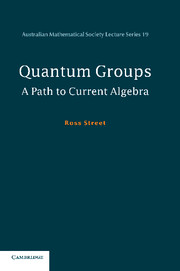Book contents
- Frontmatter
- Contents
- Introduction
- 1 Revision of basic structures
- 2 Duality between geometry and algebra
- 3 The quantum general linear group
- 4 Modules and tensor products
- 5 Cauchy modules
- 6 Algebras
- 7 Coalgebras and bialgebras
- 8 Dual coalgebras of algebras
- 9 Hopf algebras
- 10 Representations of quantum groups
- 11 Tensor categories
- 12 Internal homs and duals
- 13 Tensor functors and Yang–Baxter operators
- 14 A tortile Yang–Baxter operator for each finite–dimensional vector space
- 15 Monoids in tensor categories
- 16 Tannaka duality
- 17 Adjoining an antipode to a bialgebra
- 18 The quantum general linear group again
- 19 Solutions to Exercises
- References
- Index
3 - The quantum general linear group
Published online by Cambridge University Press: 15 December 2009
- Frontmatter
- Contents
- Introduction
- 1 Revision of basic structures
- 2 Duality between geometry and algebra
- 3 The quantum general linear group
- 4 Modules and tensor products
- 5 Cauchy modules
- 6 Algebras
- 7 Coalgebras and bialgebras
- 8 Dual coalgebras of algebras
- 9 Hopf algebras
- 10 Representations of quantum groups
- 11 Tensor categories
- 12 Internal homs and duals
- 13 Tensor functors and Yang–Baxter operators
- 14 A tortile Yang–Baxter operator for each finite–dimensional vector space
- 15 Monoids in tensor categories
- 16 Tannaka duality
- 17 Adjoining an antipode to a bialgebra
- 18 The quantum general linear group again
- 19 Solutions to Exercises
- References
- Index
Summary
The passage from quantum to classical mechanics is quite well defined by taking the limit as Planck's constant h tends to 0. The passage in the other direction is not so clear cut, and may not be uniquely determined. On the algebraic side, “quantization” involves deforming commutative algebras to non-commutative ones:
Usually we deal with q = eh rather than h, so classical results correspond to the case q = 1. Quantum spaces correspond to more general k-algebras, not necessarily commutative.
Let k be a fixed field and fix q ∈ k with q ≠ 0. Write k〈x1, …, xn〉 for the k-algebra of polynomials in non-commuting indeterminates x1, …, xn. As a vector space over k, a basis is given by those elements
for which r ∈ ℕ and m1, …, mr ∈ ℤ+ and ξ : {1, …, r} → {1, …, n} is any function. Notice that
The coordinate algebra of the space of quantum 2 × 2 matrices is defined by
where R is the system of equations
(mnemonic)
The monomials a m1bm2cm3dm4 form a basis for the algebra, as a vector space over k.
is an A-point of Mq−1(2).
The above result can be proved by direct calculation, but this gives little insight into the special nature of the relations R. Examples such as this arose in work of L. D. Fadde′ev [FRT88] and his school on the quantum inverse scattering transform (QIST) method.
- Type
- Chapter
- Information
- Quantum GroupsA Path to Current Algebra, pp. 9 - 12Publisher: Cambridge University PressPrint publication year: 2007



